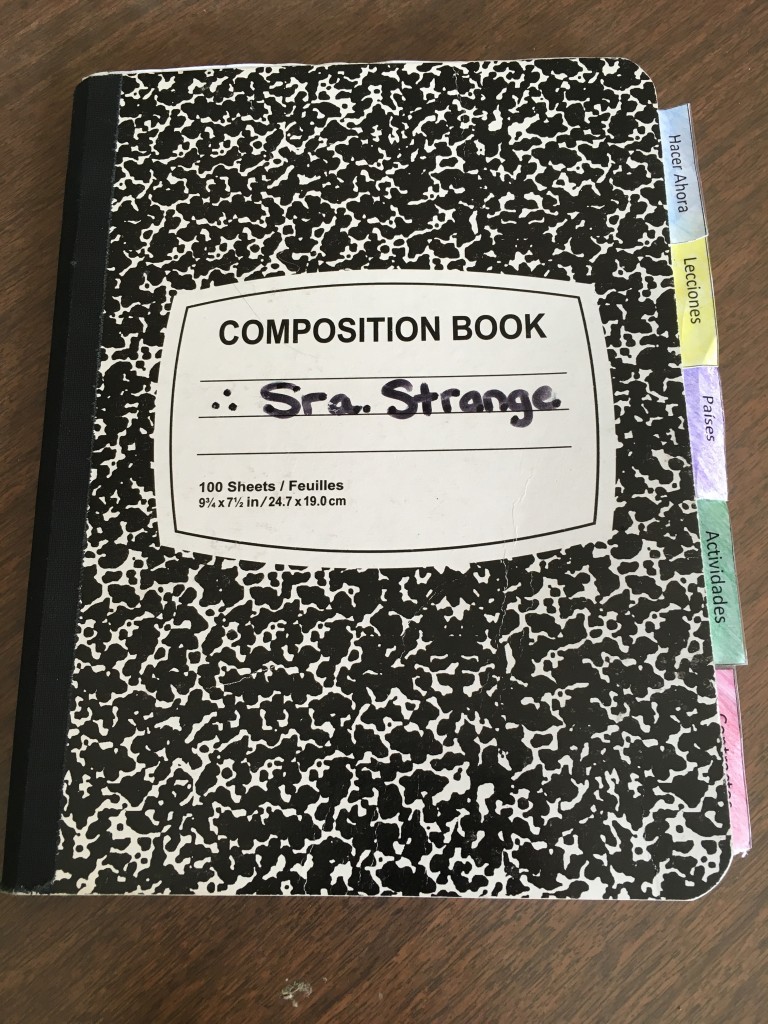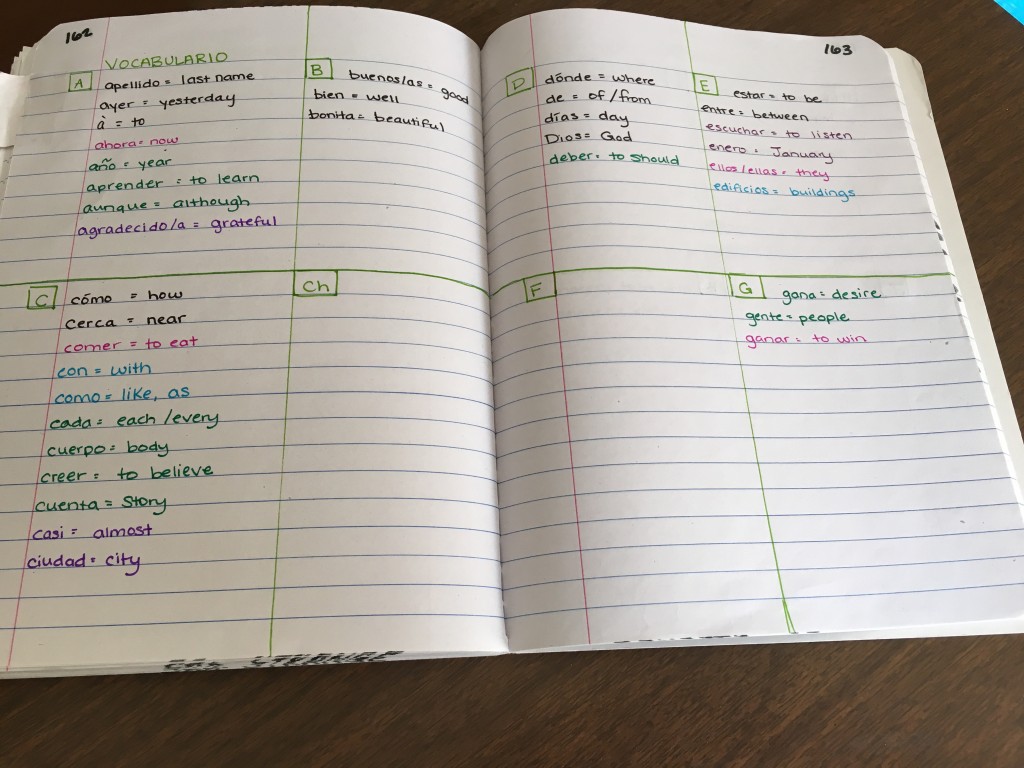I am thrilled to get to share my experience with interactive journals in the Spanish classroom – they have worked incredibly and I will definitely be using them again next year! These particular ones are set up for middle school or higher but they could easily be adapted to elementary level and to different subject areas.
I had students bring in a plain black composition book (not a spiral notebook because the spirals get messed up and students are tempted to rip out pages for other activities). It would be preferable for students to choose one that has 100 sheets to be sure that there is enough room. Students then followed very detailed instructions to get them properly set up. This took up an entire class period but it was well worth it! Sacrificing one class period for a year’s worth of smooth transitions and good organization is a pretty good bargain if you ask me. Students had to put their full name on the front cover as well as on the top and bottom of the book so that notebooks could be easily located in a basket no matter which direction they were oriented.

Students then numbered all of their pages at the top corner in a visible marker, large enough to be seen. Pages were numbered front and back so that your 100 sheet composition book had 200 pages. Once the pages were correctly numbered (you have to impress on students to be careful in this section so that they do not skip pages) they were given little paper tabs that were labelled: Hacer Ahora (Do Now), Lecciones (Lessons), Paises (Countries), Actividades (Activities), Contractos (Contracts), and Vocabulario (Vocabulary). Students could color these with colored pencils if they so desired. Students then cut out each of these squares and glued them to the page in their notebook as directed (so that all tabs for all students were in the same order and orientation). I wound up adding the Vocabulario section to their notebooks later and it was much needed! I encourage you to do that from the beginning if you decide that you would like to use this system in your classroom. Since I did not pre-plan that section, the tab had to be added as a “second row” in that back of the book. Once the tabs are correctly glued, so that half of the tab (the part with the word) hangs over edge evenly, students were given a piece of large clear tape with which to “laminate” each tab by taping over it. It actually looks really good when finished, not like tape at all, and it keeps the tabs from ripping, wearing, or becoming frayed over time. Especially necessary since my students keep their books in baskets in the classroom where they are routinely abused by classes searching for their own books among them.

I mentioned that I added the Vocabulario section later and therefore it was not a part of a my original class set-up. Next year it will be though! In this section I had students divide several pages into four boxes, enough so that there was one for each letter of the Spanish alphabet. I then had them write the target letter in each box, in order! In each of these boxes students record new words that we learn, organizing them alphabetically. This has been one of the major catalysts for their success in language acquisition. Students are also encouraged to add their own words to these sections as they encounter words that they would like to remember. This becomes a valuable resource for them when they need to look up a word they know they have seen before or when they need to use vocabulary words to complete a contracto. If/when a student runs out of room in a particular box, I provide them with a sticky note to place over the box and continue. That way all of the words are still in the same section and it is easy to see them all.

Other things that I have had students add to their journals over time include a Quick-Reference Guide and an envelope for a Verb Chart. These have both come in very handy. On the back inside of their journal I had students glue an envelope (to cut down on cost I had them all make their own through origami out of copy paper) and a small square of construction paper (color of their choice). I printed out a verb chart for every student as soon as we learned about verbs (I choose to cover all verb endings around the fourth week of school, I know that is earlier than most curriculum suggest but I have found that it is helpful for providing a full framework for students so they can feel like they are really do something. I do not have them memorize the endings until much much later). These charts are just a small sheet of paper that outline all of the endings for present tense -ar, -er, and -ir verbs. Students fold these up and put them in the envelope so that they can be quickly accessed. I allow them to use these for Minuto Locos, translation, activities, and for the first several tests and quizzes. I have found that giving students plenty of time to use the verb chart before requiring them to memorize the endings, helps them really grasp the concept and they often accidentally memorize it without you having to ask them to do so! Win, win! But I digress, on the construction paper, students record phrases that are important and frequently used. I have them record phrases like: “I don’t know,” “I don’t understand,” “Please repeat,” “Please slow down,” “How do you say…in Spanish?,” and “What does … mean?” These are phrases that they may need to use in the classroom or are likely to need to use in a conversation with a native or more advanced speaker.
These journals have worked wonderfully for us in Spanish class. It helps students be more organized, it is easy for parents to see exactly what we are learning in class (and easier for students to explain their homework or material to their parents), it keeps students engaged during class, it gives students something to have ownership of, and it incorporates the opportunity for creative learning in the classroom. I have supplied every table with scissors, pens, colored pencils, markers, and glue sticks to be sure that these journals are a success and that they help the class run more smoothly. If you have used interactive journals in your classroom I would love to hear from you and some of the things that you may have done the same or differently!
